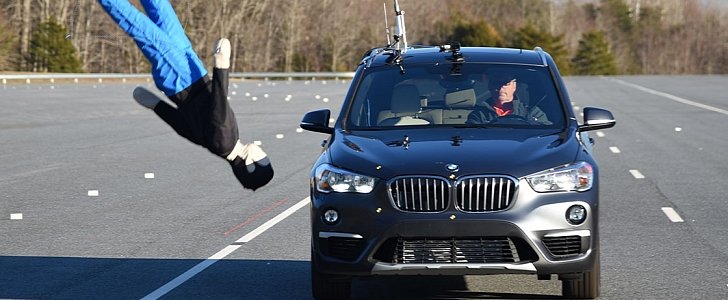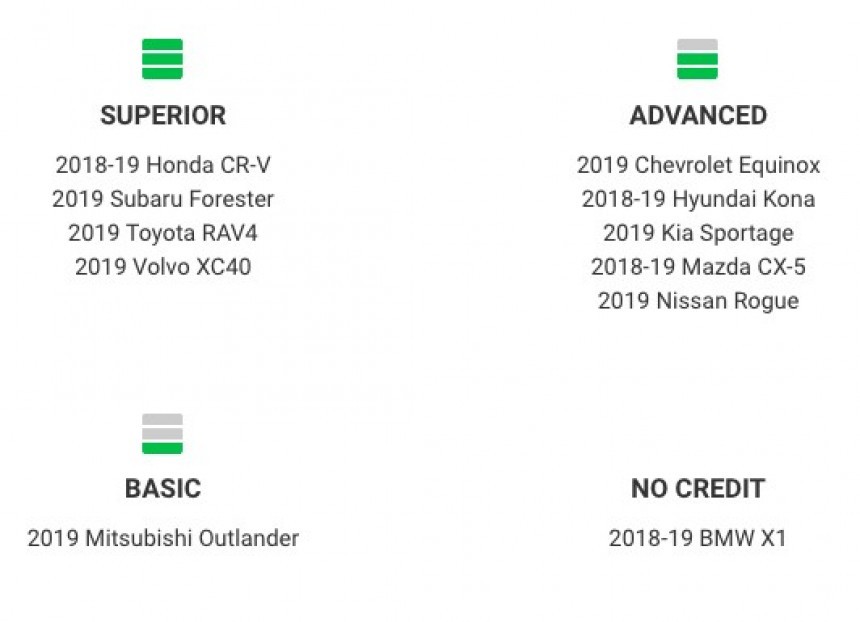When buying a new car that’s equipped with pedestrian crash prevention nannies, don’t be fooled into thinking all these systems are as competent or they work just as well.
According to a recent bout of testing carried out by the Insurance Institute for Highway Safety (IIHS), their performance varies considerably.
Just because a car has the autonomous emergency braking that on the box says should stop for pedestrians, doesn’t mean it’ll actually be particularly good at it. In fact, out of a batch of 16 cars recently tested by the IIHS, there were a few whose pedestrian-detecting AEB just didn’t work at all in certain situations.
Some cars’ AEBs just rely on a single forward-facing camera, or two of them, but the best systems on the market add an extra layer of protection by also relying on radar sensors located somewhere in the nose of the car (some have these sensors in the grille, others have it lower down on the bumper and some cars even disguise them as fog lights).
Out of all 16 vehicles tested, only 12 came with pedestrian detection and AEB as standard, but just because the car has the system, doesn’t automatically mean it will work in every situation. The IIHS found that while some cars ground to a halt when the pedestrian was detected, others hardly scrubbed off any speed.
It was found that the best vehicles were from luxury automakers, namely the Audi A4, BMW 3 Series, Mercedes-Benz C-Class and Volvo S60. However, two non-premium models also stood out, achieving similar if not better performance - the Nissan Maxima and the Subaru Outback.
At the other end of the spectrum, of cars whose pedestrian-detecting AEB didn’t work as planned, we have Ford Fusion that only barely reduced its speed in some instances, while in others, it didn’t really react - the situation when a child pops out from behind parked cars really startled the Ford’s system and it remained inactive.
The Hyundai Sonata and Kia Optima didn’t fare any better than the Fusion. They had the exact same issues and earned a No Credit rating from the IIHS - that essentially means their pedestrian-detection function of their AEB is basically useless, or it hardly does anything.
The IIHS awarded a Basic rating to the Chevy Malibu (equipped with either the optional pedestrian-detecting front camera or the camera and radar combo, which didn’t really make a big difference), as well as the Mercedes-Benz C-Class with the standard AEB (although the C-Class actually got a Superior rating with the more advanced optional AEB fitted).
Interestingly, the BMW 3 Series only got the Advanced rating when equipped with the more advanced optional AEB, yet it was rated Superior with the standard system all examples come with.
It appears that some manufacturers’ AEB solutions are better than others - Subaru and Volvo consistently score very highly for safety, but this doesn’t always stand true. When the IIHS tried the pedestrian braking function of the BMW X1 (and other small SUVs), well, it failed to brake at all in some situations.
The Toyota RAV-4 and Subaru Forester avoided hitting the child dummies in every single test, while the Volvo XC40 managed an almost identical performance.
What all of this entails is that if having this autonomous emergency braking function with pedestrian detection is a priority for you when looking for your next car, you really should do some research. Just because a manufacturer says its car will do something, it doesn’t actually mean it will work as well every time.
AEB with pedestrian detection is definitely a lifesaver, since pedestrians are highly vulnerable, especially as more and more tall SUVs with bulky front ends are sold. You really can’t put a price on a vehicle’s ability to brake on its own before you even have a chance to react (and thus save a life or avoid serious injury), but be aware that even though on paper most new cars sound like they are as good, they really are not.
Just because a car has the autonomous emergency braking that on the box says should stop for pedestrians, doesn’t mean it’ll actually be particularly good at it. In fact, out of a batch of 16 cars recently tested by the IIHS, there were a few whose pedestrian-detecting AEB just didn’t work at all in certain situations.
Some cars’ AEBs just rely on a single forward-facing camera, or two of them, but the best systems on the market add an extra layer of protection by also relying on radar sensors located somewhere in the nose of the car (some have these sensors in the grille, others have it lower down on the bumper and some cars even disguise them as fog lights).
Out of all 16 vehicles tested, only 12 came with pedestrian detection and AEB as standard, but just because the car has the system, doesn’t automatically mean it will work in every situation. The IIHS found that while some cars ground to a halt when the pedestrian was detected, others hardly scrubbed off any speed.
At the other end of the spectrum, of cars whose pedestrian-detecting AEB didn’t work as planned, we have Ford Fusion that only barely reduced its speed in some instances, while in others, it didn’t really react - the situation when a child pops out from behind parked cars really startled the Ford’s system and it remained inactive.
The Hyundai Sonata and Kia Optima didn’t fare any better than the Fusion. They had the exact same issues and earned a No Credit rating from the IIHS - that essentially means their pedestrian-detection function of their AEB is basically useless, or it hardly does anything.
The IIHS awarded a Basic rating to the Chevy Malibu (equipped with either the optional pedestrian-detecting front camera or the camera and radar combo, which didn’t really make a big difference), as well as the Mercedes-Benz C-Class with the standard AEB (although the C-Class actually got a Superior rating with the more advanced optional AEB fitted).
Interestingly, the BMW 3 Series only got the Advanced rating when equipped with the more advanced optional AEB, yet it was rated Superior with the standard system all examples come with.
It appears that some manufacturers’ AEB solutions are better than others - Subaru and Volvo consistently score very highly for safety, but this doesn’t always stand true. When the IIHS tried the pedestrian braking function of the BMW X1 (and other small SUVs), well, it failed to brake at all in some situations.
What all of this entails is that if having this autonomous emergency braking function with pedestrian detection is a priority for you when looking for your next car, you really should do some research. Just because a manufacturer says its car will do something, it doesn’t actually mean it will work as well every time.
AEB with pedestrian detection is definitely a lifesaver, since pedestrians are highly vulnerable, especially as more and more tall SUVs with bulky front ends are sold. You really can’t put a price on a vehicle’s ability to brake on its own before you even have a chance to react (and thus save a life or avoid serious injury), but be aware that even though on paper most new cars sound like they are as good, they really are not.















